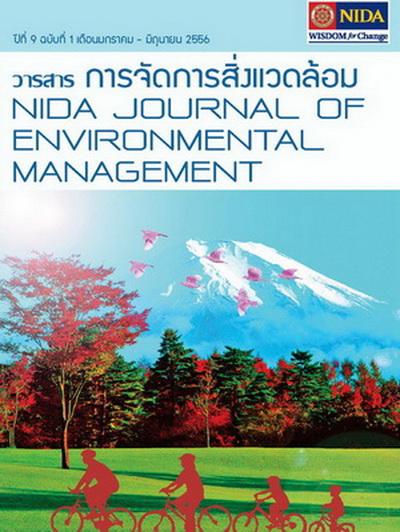Measuring Fine Particles to Assess Secondhand Smoke Exposure:Evidence Contributing to Smoke-free Regulation
บทคัดย่อ
บทคัดย่อ
นโยบาย การควบคุมยาสูบของประเทศไทยได้ผลักดันให้มีการลดการรับสัมผัสควันบุหรี่มือ สองเพื่อปกป้องสุขภาพผู้ไม่สูบบุหรี่มากว่า 20 ปีแล้ว ในการเสริมสร้างความเข้มแข็งแก่กฎหมายปลอดบุหรี่นั้น จะต้องมีหลักฐานเชิงประจักษ์ประกอบในการขับเคลื่อนภารกิจนี้ การศึกษานี้มีวัตถุประสงค์เพื่อตรวจวัดระดับของควันบุหรี่มือสองในสถาน ประกอบการหลายประเภท เพื่อดูลักษณะปัญหาคุณภาพอากาศภายในอาคารในประเทศไทย วิธีการเก็บตัวอย่างและวิเคราะห์ตัวอย่างฝุ่นละอองขนาดเล็ก (PM 2.5) ซึ่งเป็นตัวชี้วัดมลพิษจากควันบุหรี่มือสองนั้น ใช้วิธีการและอุปกรณ์ปรับเทียบมาตรฐาน ตามวิธีการที่ใช้ในโครงการสำรวจและตรวจสอบอากาศสากลที่ประเทศไทยเป็นส่วน หนึ่งของโครงการความร่วมมือนี้ มีการเก็บตัวอย่าง PM 2.5 จำนวน 53 ตัวอย่างจากสถานประกอบการต่าง ๆ เช่น ร้านอาหาร บาร์ สถานีขนส่ง ทั้งที่มีการสูบบุหรี่ (26 แห่ง) และไม่มีการสูบบุหรี่ (27 แห่ง) พบว่าค่าเฉลี่ยของ PM 2.5 ในสถานประกอบการที่มีการสูบบุหรี่เท่ากับ 319 ไมโครกรัมต่อลูกบาศก์เมตร และในสถานที่ที่ไม่มีการสูบบุหรี่ เท่ากับ 29 ไมโครกรัมต่อลูกบาศก์เมตร เมื่อเปรียบเทียบกับเกณฑ์มาตรฐานฝุ่นขนาดเล็กขององค์กรพิทักษ์สิ่งแวดล้อม สหรัฐอเมริกา พบว่าในสถานประกอบการที่มีการสูบบุหรี่นั้นค่าเฉลี่ยระดับฝุ่นขนาดเล็กเป็น 21 เท่าของค่ามาตรฐานเฉลี่ยตลอดปี (15 ไมโครกรัมต่อลูกบาศก์เมตร) และเป็น 9 เท่าของค่ามาตรฐานเฉลี่ย 24 ชั่วโมง (35 ไมโครกรัมต่อลูกบาศก์เมตร) ค่าเฉลี่ยสูงสุดของฝุ่นขนาดเล็กที่วัดได้ในบาร์คือ 488 ไมโครกรัมต่อลูกบาศก์เมตร ซึ่งเป็น 14 เท่าของค่ามาตรฐานเฉลี่ย 24 ชั่วโมง กระบวนการออกกฎหมายนั้นต้องอ้างอิงหลักฐานเชิงประจักษ์ พิจารณาทางเลือกในการแก้ไขปัญหา และ สร้างกรอบของกฎข้อบังคับที่จะให้มีการปฏิบัติตามได้มากที่สุด ซึ่งผลการศึกษานี้แสดงให้เห็นว่าการวิจัยที่สนับสนุนนโยบาย สามารถส่งผลให้เกิดกลยุทธ์ในการตอบสนองต่อภาวะคุกคามทางสิ่งแวดล้อมที่สำคัญ เช่น การรับสัมผัสควันบุหรี่มือสอง ได้ทันสถานการณ์
คำสำคัญ: การรับสัมผัสควันบุหรี่มือสอง; ฝุ่นละอองขนาดเล็ก (PM2.5); นโยบายสิ่งแวดล้อม; สถานประกอบการ; กฎหมายปลอดบุหรี่
Abstract
Reducing exposure to secondhand smoke to protect the health of nonsmokers has been the central thrust of tobacco control in Thailand for 20 years. The strengthening of smoke-free regulation required producing evidence for this task. Our aim was to examine the levels of secondhand smoke in a variety of occupational settings to characterize the extent of the indoor air problem in Thailand. As part of a collaborative study, the Global Air Monitoring Survey, a standardized protocol and calibrated air sampling instrument, was used to collect and analyze samples of fine particles (PM 2.5), indicators of secondhand smoke pollution. Fifty-three samples of PM 2.5 were collected from workplaces such as restaurants, bars, and transportation stations, where smoking was present (26 venues) and where there was no smoking (27 venues). The mean level of PM 2.5 in establishments with smoking present was 319 micrograms per cubic meter, and 29 micrograms per cubic meter where there was no smoking. When compared to the US Environmental Protection Agency (EPA) particulate standards, the level in venues with smoking present was twenty-one times higher than the annual standard of 15 micrograms per cubic meter, and over nine times the 24 hour standard of 35 micrograms per cubic meter. The highest mean level was in bars, 488 micrograms per cubic meter, about fourteen times the 24 hour standard. Regulatory processes involve assessing existing evidence, examining alternative solutions, and building a regulatory framework that maximizes compliance. Our experience shows that policy supportive research activities can result in strategic steps to respond in a timely manner to an important environmental threat such as secondhand smoke exposure.
Keywords: Secondhand Smoke Exposure; PM2.5; Environmental Policy; Workplace; Smoke-Free Regulation



